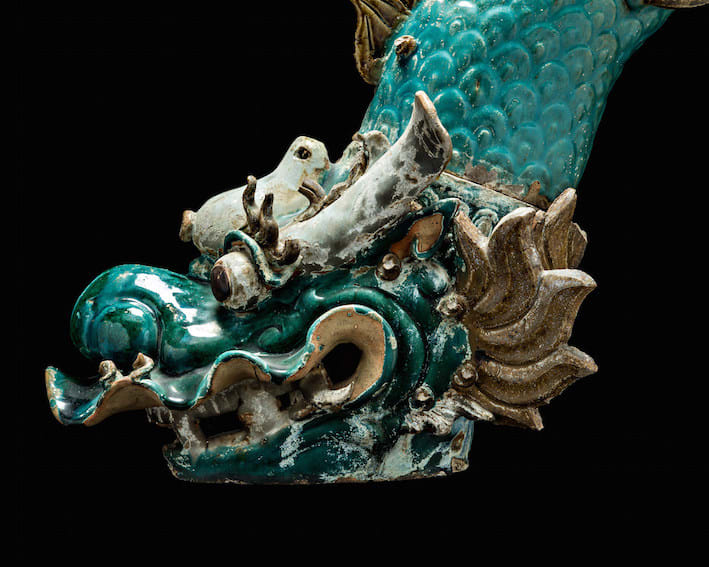Ming Dynasty Glazed Architectural Sculpture of a Fish, AD 1368 - AD 1644
Ceramic, Pigment
82.3 x 30.4 x 58.5 cm
32 3/8 x 12 x 23 in
32 3/8 x 12 x 23 in
TF.035
Further images
This astonishing piece is a dragonfish, a symbol of good luck, prosperity and success in Chinese society. Its remarkable features are unrelated to those of the taxonomically-valid “dragon-fish”, and instead...
This astonishing piece is a dragonfish, a symbol of good luck, prosperity and success in Chinese society. Its remarkable features are unrelated to those of the taxonomically-valid “dragon-fish”, and instead reflect an agglomeration of features in the same way that “foo dogs” resemble lions; it possesses a fusion of dragon-like and leonine characteristics, fused into an arresting whole and painted in vivid polychrome colours. The function of the piece was unlike the majority of ceramic Chinese sculptures – which were “mingqi” objects designed to accompany their owner into the hereafter as tomb attendants – but instead were used as decorations for the roofs of public buildings (especially temples) in the same way as M’ing Dynasty polychrome wall panels. For this reason, the piece has been thoroughly and intensely glazed. It can, however, be disassembled into its main constituent parts, and has been mounted on a specially-designed stand. It is a match for TF.033 and TF.034.
Established in 1368, the M’ing dynasty was founded by Hong Wu, one of only three peasants ever to rise to imperial pre-eminence. His attitudes towards rule reflected his own past, with considerable emphasis on agricultural production, an aversion to trade, a massive expansion of military power and spending a fortune on defences (notably the Great Wall). This philosophy, while partly reflexive, was based loosely upon Confucianism, with which China had had a love-hate relationship for much of the preceding millennium. Despite his prejudices, the inevitable effect of Hong Wu’s policies was stability, and with it the rise and rise of the middle classes. While in many respects a martially vigorous and ascetic time, the enormous wealth generated by agricultural surpluses led to an unexpected flowering of arts under the patronage of what was essentially the nouveau riche, who liked to surround themselves with artworks including lacquer work, paintings, prestige ceramics and sculptures both for this life and for the hereafter (mingqi). Many public-minded personages sponsored temples and other important buildings, which were often decorated with pieces such as this.
This is an extraordinarily rare, beautiful and ornate piece of M’ing Dynasty art.
Established in 1368, the M’ing dynasty was founded by Hong Wu, one of only three peasants ever to rise to imperial pre-eminence. His attitudes towards rule reflected his own past, with considerable emphasis on agricultural production, an aversion to trade, a massive expansion of military power and spending a fortune on defences (notably the Great Wall). This philosophy, while partly reflexive, was based loosely upon Confucianism, with which China had had a love-hate relationship for much of the preceding millennium. Despite his prejudices, the inevitable effect of Hong Wu’s policies was stability, and with it the rise and rise of the middle classes. While in many respects a martially vigorous and ascetic time, the enormous wealth generated by agricultural surpluses led to an unexpected flowering of arts under the patronage of what was essentially the nouveau riche, who liked to surround themselves with artworks including lacquer work, paintings, prestige ceramics and sculptures both for this life and for the hereafter (mingqi). Many public-minded personages sponsored temples and other important buildings, which were often decorated with pieces such as this.
This is an extraordinarily rare, beautiful and ornate piece of M’ing Dynasty art.







